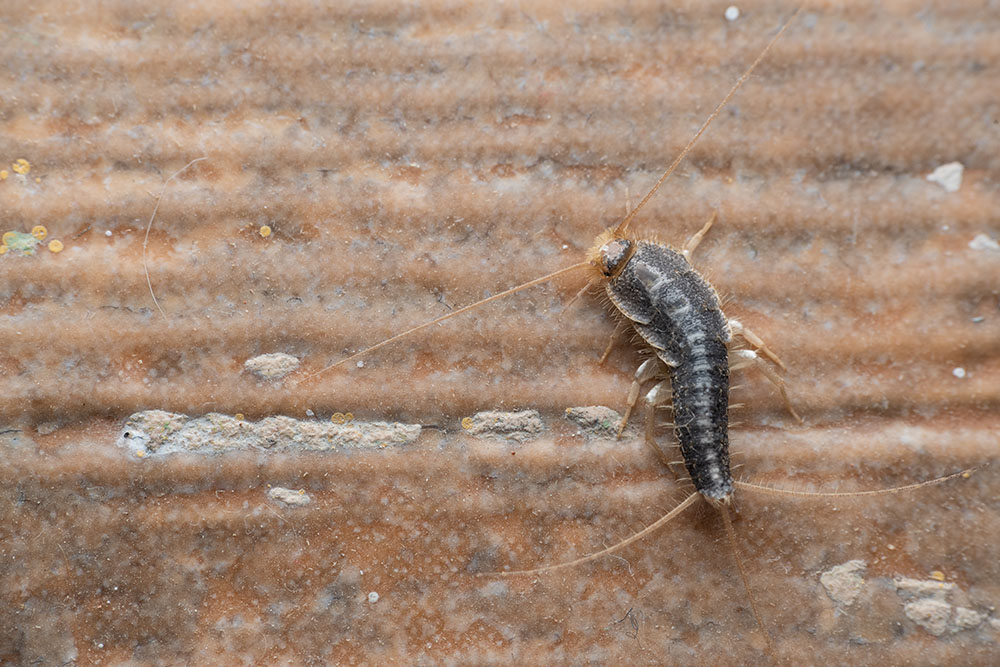Does A Silverfish Infestation Mean You Have Mould?

CONTENTS
- Understanding silverfish infestations
- Identifying signs of silverfish infestation
- Moisture control strategies to deter silverfish and mould
- The impact of mould on home environments
- Remediation techniques for mould and silverfish infestations
- Monitoring and maintenance post-infestation
- Frequently asked questions
- Get in touch
Silverfish are insects you may have mistaken for woodlouse or similar wingless insects that linger in moist areas. They can be commonly found in your bathroom, coming out at night to feed off materials in your home. However, their appearance could mean something more troubling: leaks and mould.
At ICE Cleaning, we offer mould cleaning services that can help identify the root cause of mould and remove silverfish nests that may be hiding in your home. Our industrial-grade tools and solutions can control the spread of mould, helping to prevent it in your home in the future.
Read on to learn more about silverfish and what they imply about your indoor environment.
Understanding silverfish infestations
Silverfish are small wingless insects that have existed for over 300 million years. They are nocturnal creatures and prefer to dwell in dark, damp environments. The presence of silverfish in a home can indicate underlying issues related to moisture control and humidity.
The biology and behaviour of silverfish
Silverfish have an elongated body structure covered with silvery scales. They reproduce rapidly under favourable conditions, leading to significant infestations if not addressed promptly.
A unique characteristic behaviour of these pests is their diet - they feed on carbohydrates such as sugars or starches in various household items like paper, clothing, wallpaper glue and even moulds or fungi.
This dietary preference explains why you might find them lurking around your bathroom tiles or kitchen cupboards.
Environmental conditions favouring silverfish infestation
Humidity plays a crucial role in the survival and reproduction rate of silverfish. They thrive best at relative humidity levels above 75% with temperatures between 25°C to 27°C.
Therefore, homes with poor ventilation systems provide ideal breeding grounds for them. Additionally, cluttered spaces provide excellent hiding spots for silverfish during daytime hours, encouraging population growth within residential buildings.
The interplay between mould growth and silverfish infestation
Mould growth is linked to high humidity levels within an environment - similar conditions that attract silverfish infestations. The presence of mould provides a direct food source for these pests, establishing a relationship between the two.
This suggests that if you are dealing with a silverfish infestation in your home, it might also be worth investigating potential mould growth issues, as they could be part of the same underlying problem related to moisture control and humidity within your property.
Identifying signs of silverfish infestation
Silverfish have a distinctive appearance, with elongated bodies covered in silvery scales and long antennae. They move quickly and are active at night, making them difficult to spot. However, one may find them hiding in dark corners or near sources of moisture, like bathrooms or kitchens.
- Paper damage: Silverfish feed on carbohydrates in various household items like books, wallpaper glue, insulation materials and more.
- Faecal matter and scales: Their droppings appear as tiny black specks, while discarded scales resemble miniature fish shapes.
- Yellow stains: When silverfish moult, they leave behind yellow stains on various surfaces.
If you suspect a silverfish infestation, it is advisable to seek professional help. ICE Cleaning provides specialist cleaning services that can effectively address pest and potential mould issues.
Moisture control strategies to deter silverfish and mould
Silverfish infestations and mould growth in residential properties are caused by high humidity levels. You can control these through practical moisture control strategies:
- Maintain good ventilation: Regularly open windows after bathing, showering or cooking and install exhaust fans to circulate air
- Use dehumidifiers: Use these to lower relative humidity and keep it below 50% where possible
- Repair leaks: Leaking pipes, roofs, or walls encourage silverfish breeding and mould growth - repairing leaks prevents this
- Anti-mould materials: Use building materials and paints that are either mould or water-resistant
- Storage practices: Avoid storing things in cardboard or fabric boxes - opt for plastic containers and practice good ventilation in storage areas
Implementing these moisture control strategies can reduce the risk of silverfish infestations and mould growth, contributing towards a healthier living environment within your residential property.
The impact of mould on home environments
Mould poses significant risks to the structural integrity of buildings and indoor air quality. Its presence often indicates underlying issues with moisture control within a property.
Effects on structural integrity
When mould infiltrates building materials such as wood or drywall, it can lead to their deterioration over time.
The biodegradation process, where mould feeds off organic material in these substances, compromises their strength and stability. This degradation leads to costly repairs and threatens the safety of occupants if left unchecked.
Influence on indoor air quality
Mould impacts indoor air quality by releasing microscopic spores into the environment. These airborne particles can trigger allergies and exacerbate respiratory conditions like asthma when inhaled.
Certain types of mould produce mycotoxins, which are harmful substances linked to health concerns, including neurological problems and immune system suppression.
Mitigating the risks of mould growth
It is crucial to maintain an environment unsuitable for mould growth to mitigate these risks. This involves controlling humidity levels, ensuring proper ventilation, promptly addressing leaks or water damage, and regularly inspecting areas prone to dampness, like bathrooms and basements.
Remediation techniques for mould and silverfish infestations
Severe mould and silverfish infestations require professional intervention from specialist cleaning services like ICE Cleaning. We employ comprehensive remedial techniques like:
- Mould removal: This involves using special equipment to thoroughly dry out affected areas, followed by antimicrobial treatments designed to kill existing spores while preventing future growth.
- Silverfish extermination: A combination of pesticide applications targeting adult populations and Insect Growth Regulators (IGRs) to disrupt life cycle stages, reducing population numbers.
- Ventilation improvements: Modifications are recommended to improve air circulation, reducing humidity levels within the property.
It is important to remember that while these methods are effective, they should be conducted by trained professionals due to potential health risks associated with mould exposure and pesticide use.
Furthermore, early detection through regular property inspections can prevent escalation of infestations, saving considerable time and expense in remediation efforts.
Monitoring and maintenance post-infestation
The process of managing a silverfish infestation does not end with the elimination of these pests. It is essential to continue monitoring your home environment for signs of recurrence, and other related issues such as mould growth.
Ongoing vigilance: a key preventive measure
To prevent a re-infestation, you must maintain an ongoing vigilance post-infestation. Regularly inspect areas where silverfish are most likely to thrive - damp and dark spaces like basements, attics, kitchens, and bathrooms.
Watch out for their distinctive tear-shaped bodies or tell-tale signs such as yellow stains or holes in paper materials.
Moreover, given the link between moisture levels, mould growth and silverfish attraction, monitoring humidity levels within your property should form part of this regular inspection routine.
Maintaining optimal environmental conditions
Silverfish thrive in environments with high humidity; therefore controlling environmental conditions can help deter these pests from returning. Aim for relative humidity below 50% by improving ventilation and using dehumidifiers, especially in prone areas like bathrooms or kitchens.
Mould similarly thrives under humid conditions but also requires organic material (like wood) to grow. So, maintaining cleanliness can also be effective at preventing its development.
Frequently asked questions
Why have I got lots of silverfish in my house?
Silverfish thrive in damp, dark areas. Your home might be offering the perfect hideout with enough moisture and food.
How do you get rid of a silverfish infestation?
Cut down on humidity, clean up clutter, and seal cracks to stop them from sneaking in.
Should I be worried if I have silverfish?
Silverfish are harmless but too much dampness could lead to mould or other pests.
How do you find a silverfish nest?
Spotting these insects at night can guide you to their nests — usually warm spots near paper or fabric stashes.
Get in touch
For leading mould remediation services, get in touch with our team today at ICE Cleaning. We utilise state-of-the-art technology to remove all traces of mould and its spores across your property and eliminate pests like silverfish and other mould-related insects.
To learn more about our mould removal services, contact our team today at [TELELPHONE] or enquiries@icecleaning.co.uk. We operate nationwide, ensuring you receive the best care 24/7, 365 days a year.

Speak with me today,
I’m here to help
By asking you a few questions either via phone or email I can immediately provide a realistic estimation of the cost.
You’re in good company. We’ve cleaned for the following commercial clients… View all

Why choose us?
- Cater to a wide variety of cleaning situations
- Nationwide coverage, available 24/7
- Cater to commercial and domestic clients
- Free survey provided prior to quotation
- Emergency response team
- Offer a bespoke service designed to suit all your needs
- All technicians hold professional health and safety qualifications, including BICSc, IOSH, Dewpoint Professional & Safe Contractor
We’re fully accredited
We place best practise, professional expertise and health and safety at the core of our business. We’re fully compliant with all legal obligations. You can view a list of our accreditations below, or visit our Health & Safety page for more information.











-RGB-small.1707319151.jpg)




















